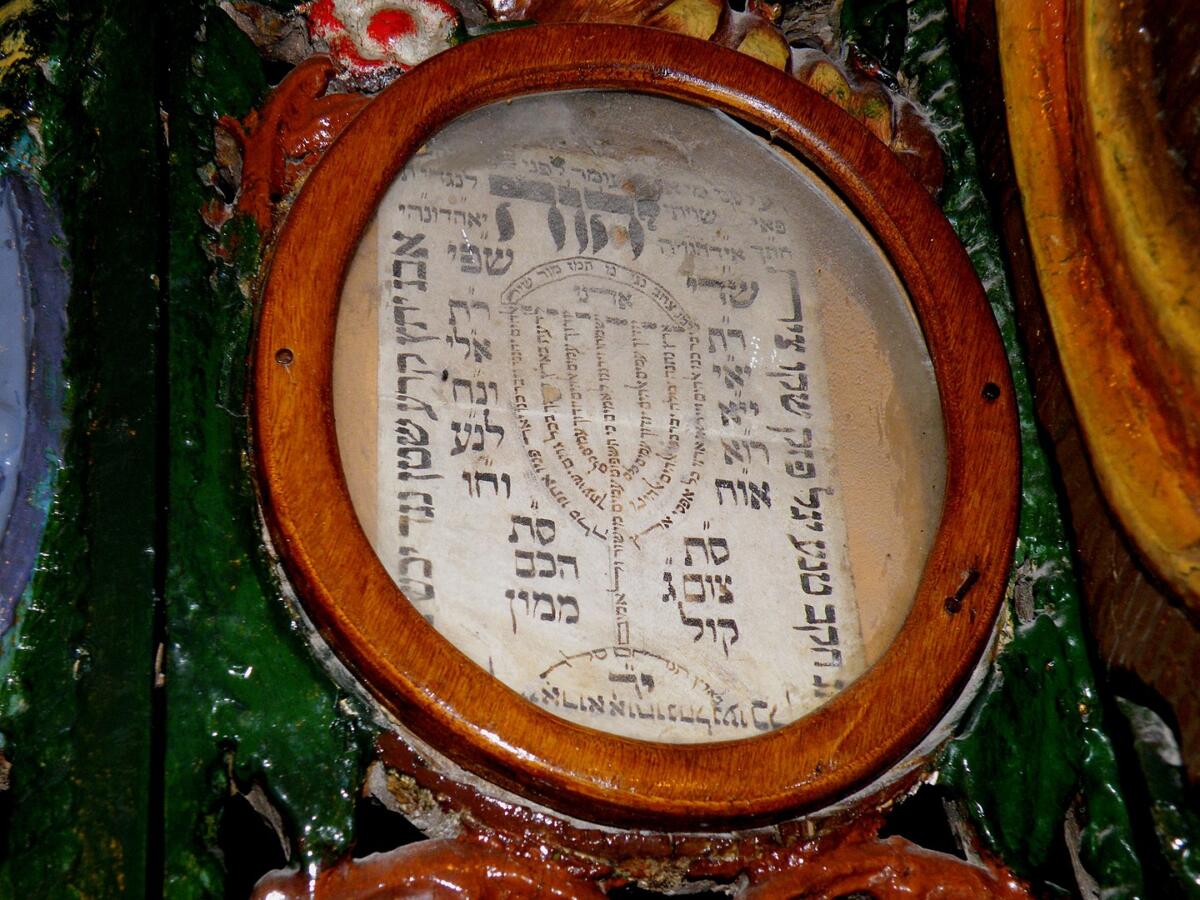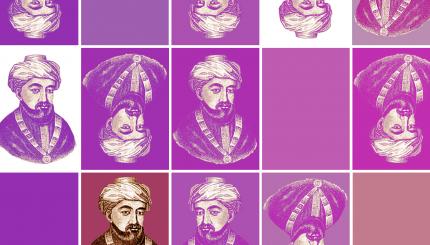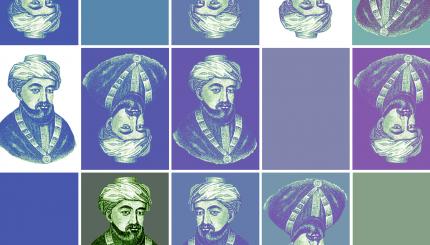Isaac Luria taught what amounts to a 16th-century version of a gnostic myth, organized around three main themes: tzimtzum [“contraction”], shevirat ha-kelim [“the shattering of the vessels”], and tikkun [“repair” or “fixing”].
God Contracts the Divine Essence
In contrast to the mythological conceptions of early Kabbalah, which conceived of the initial theogonic [self-creative] activity as an outward act of emanation, Luria describes the first action of divinity as an inward one. Tzimtzum refers to the process by which the Godhead contracts its essence, so to speak, by retreating “from Himself into Himself,” abandoning a space in order to create an “empty” region.
[The explanation of this] step inward sought to solve the question of how the existence of the world is possible if divinity, which is Infinite, fills all space. The answer which Lurianic provides is that by an act of withdrawal, a space–infinitesimally small in comparison to God‘s infinity–is created in which all dimensions of existence can unfold.
Prior to this event, the different powers of divinity were harmoniously balanced without any apparent individuation or differentiation. In particular, the opposing forces of Mercy (Hesed) and Stern Judgment (Din) existed in a state of complete unity. But in the course of tzimtzum, Ein Sof [God’s essence referred to by the name “There-Is-No-Limit”] gathered in one place all the “roots” of Stern Judgment, leaving them behind in the region now abandoned.

Help us keep Jewish knowledge accessible to millions of people around the world.
Your donation to My Jewish Learning fuels endless journeys of Jewish discovery. With your help, My Jewish Learning can continue to provide nonstop opportunities for learning, connection and growth.
In addition, a positive residue of divine light, known as reshimu (“traces” [or impression]), remained in the empty space. This resulted in a separation between Din and Hesed and the establishment of a measure of independence for the forces of Din. Thus, from one point of view, the tzimtzum can be regarded as an act of purification in which the “dross” within God was purged from His innermost being.
“Primordial Man”
Following this, a third element, a ray from God’s hidden essence (Ein Sof) entered the empty space and acted upon the existing mixture of reshimu and Din. This illuminating ray serves as a permanent link between Ein Sof and the empty space. The form of the divine produced by this first ray of light is termed the “Primordial Man” (Adam Qadmon). The latter is described with vivid anthropomorphic detail.
The lights shining from Adam Qadmon‘s “ears,” “nose,” and “mouth” constituted a collective or perfectly unified structure. But the light issuing from the “eyes” emanated in a different manner. They were atomized or separated into different sefirot so as to require their containment in special vessels or qelim.
The Breaking of the Vessels: Broken Shards and Holy Sparks
These vessels, composed of a “thicker” light, were to serve as “shells” for the purer light. In the process of emanation, however, some of these vessels were unable to contain the fight within them, and consequently shattered under the pressure, scattering themselves into the empty space. This event is known in the Lurianic texts as “shevirat ha-qelim,” or the “breaking of the vessels.”
In the wake of this event, most of the light that had been contained in the vessels returned to their divine source, while the remainder fell below into the empty space and attached themselves to the now broken shards of vessels. From these shards of broken vessels the powers of the qelipot, that is, “husks” or “shells” were produced. These are the evil forces of the “other side,” the sitra ahra.
In addition to constituting the source of evil, the broken shards are also the basis for the material world. The sparks of light that failed to return to their source above remained trapped, as it were, among the qelipot. The qelipot, in turn, are constantly nourished and strengthened by the holy sparks attached to them. Indeed, were it not for these sparks, the qelipot would lose their life and power altogether.
Adam Could Have Fixed It All
The challenge which Lurianic teaching now faced was to determine how to mend the injury suffered by the Godhead. Tikkun refers to the processes by which restoration and repair were to be accomplished. They constitute the greatest part of Lurianic theory and are complex in the extreme.
According to Lurianic teaching, the soul of the first man, Adam, was composed of all the various “worlds” or levels of divine reality, and was intended to extricate and reintegrate the divine sparks that remained within the qelipot. When Adam was created, the cosmic process of tikkun had virtually been completed.
It was his project to finalize the restorative process through contemplative exercises. He was capable of doing, so as he was a perfect microcosm of Adam Qadmon. Through his mystical activities, Adam could have separated the sparks from their demonic shells, thus reestablishing the primordial unity of all things.
Having purged the realm of holiness of the final vestiges of dross, the qelipot would have sunk beneath the lowest spiritual worlds and lost all their power. The cosmos would have achieved the original state of perpetual communion with the divine light, and the historical process as we know it would have ended.
None of this came about, however, due to Adam’s sin. His transgression interrupted his own communion with the upper spheres and brought about his attachment to the lower worlds. Moreover, the processes of tikkun which had already taken place were reversed, the “worlds” which had begun to rise and to return to their proper position once again fell below. Good and evil were again thoroughly mixed in with each other. Humanity and all reality in the lower world of Asiyah became materialized. And the sin of Adam caused the sparks of all human souls that had been contained within his own to fall and become imprisoned as well within the qelipot.
Tikkun: Gathering Light and Souls
Tikkun, therefore, entails two separate but related processes. First, it means the gathering of the divine lights that had fallen into the realm of the qelipot as a result of the “breaking of the vessels.” Second, it means the gathering of all the holy souls likewise imprisoned in the qelipot.
Tikkun is to be achieved by human beings through their contemplative action. Every religious act requires contemplative concentration on the various dimensions of divinity and the various combinations of the divine name in order to “raise up the fallen sparks.” The focus of concentration is the inner dynamics of reorganization and restructuring that takes place in the course of acts of devotional piety.
The kinds of activities by which the kabbalist seeks to accomplish these goals include a) liturgical prayer; b) the performance of all other mitzvot; and c) the practice of certain special exercises, such as those known as yihudim [“unifications”, that is, of the Godhead]. The same general contemplative idea characterizes each of these types of activity, and [16th- and 17th-century author of the kabbalistic work The Tree of Life] Hayyim Vital’s versions of Luria’s teachings spell out the proper mystical intentions (kavvanot) in great detail.
Some General Conclusions
On the basis of the above account, several general observations pertinent to the present study may be made.
1) The condition of disarray in which the cosmos finds itself, according to Lurianic Kabbalah, is a result of two different catastrophic “falls,” one of an intra-divine nature, prior to and independent of human behavior, the other a consequence of human sin.
2) The material world as we know it, as was the case with the gnostic myths of late antiquity, is deemed repugnant, evil, inhospitable, opposed in every way to that which is immaterial, divine light and the soul.
3) The project of human life is to separate the holy from the material world, and thus divest that world of all existence. All existence will return to its original spiritual condition, a state synonymous with the messianic age. Lurianism is thus, again, like the gnostic myths of an earlier time, a complete rejection of the world as we know it, and of the historical process. The vision of redemption is a fundamentally spiritual one in which all things return to olam ha-tikkun [literally “the world of repair,” that is, a world restored to its perfect status before intra-divine catastrophe and before human sin]. Thus, the tikkun of which Lurianic Kabbalah speaks is not that of this world, but of “worlds” beyond it.
4) The responsibility for bringing all this about is a human one, not a divine one. Divinity is, in effect, a passive beneficiary of the actions of human beings.
Reprinted with the author’s permission from “Tikkun: A Lurianic Motif in Contemporary Jewish Thought,” in From Ancient Israel to Modern Judaism: Intellect in Quest of Understanding–Essays in Honor of Marvin Fox, Vol. 4, ed. Jacob Neusner et al. (Scholars Press).



